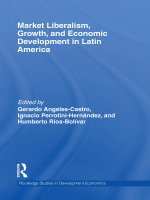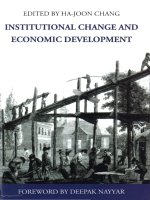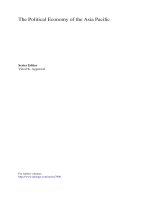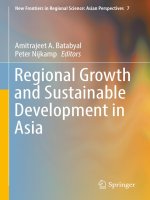Economic growth and economic development 200
Bạn đang xem bản rút gọn của tài liệu. Xem và tải ngay bản đầy đủ của tài liệu tại đây (65.16 KB, 1 trang )
Introduction to Modern Economic Growth
.
USA
10
CAN
AUS
SGP
HKG
Log GDP per capita, PPP, in 1995
NZL
CHL
9
ARG
VEN
URY
MYS
COL
BRA
BLZ
GTM
DOM
PRY
8
MEX
PAN
CRI
JAM
PHL
ECU
PER
TUN
DZA
IDN
MAR
SLV
GUY
BOL
EGY
LKAHND
NIC
VNM
HTI
PAK
IND
LAO
7
BGD
0
5
10
Urbanization in 1500
15
20
Figure 4.5. Reversal of Fortune: urbanization in 1500 versus income
per capita in 1995 among the former European colonies.
among the former European colonies reflects something unusual, something related
to the intervention that these countries experienced. The major intervention, of
course, was related to the change in institutions. As discussed above, not only did
the Europeans impose a different order in almost all countries they conquered, there
were also tremendous differences between the types of institutions they imposed on
in the different colonies.4 These institutional differences among the former colonies
are likely at the root of the reversal in economic fortunes.
To bolster this case, let us look at the timing and the nature of the reversal a
little more closely. When did the reversal occur? One possibility is that it arose
shortly after the conquest of societies by Europeans but Figure 4.8 shows that the
previously-poor colonies surpassed the former highly-urbanized colonies starting in
4In some instances, including those in Central America and India, the colonial institutions were
built on the pre-colonial institutions. In these cases, the issue becomes one of whether Europeans
maintained and further developed existing hierarchical institutions, such as those in the Aztec,
the Inca or the Mughal Empires, or whether they introduced or imposed political and economic
institutions encouraging broad-based participation and investment.
186









